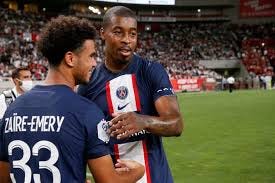PSG's Recruitment Advantage
Does Paris Saint-Germain need to splash the cash on multiple big-money signings? Location says otherwise...
With football’s worst kept secret finally out in the open, Paris Saint-Germain talisman Kylian Mbappe has told the club that he will leave in the summer, with Real Madrid looking like his next destination.
While the Parisians did their best to keep Mbappe at the club since the 2017-18 season, he’s been costing the club over 200 million euros in total wages per season (certainly since his contract extension).
Reports have indicated that PSG will use the 200 million euros that would have been allocated for Mbappe’s salary towards recruitment of players.
On a base level, that makes sense, as they will have a huge hole to fill in the absence of France’s best player.
But how will they replace him is another story.
It seems likely that PSG will target Victor Osimhen to fill the impending Mbappe-sized hole in the attack, but it won’t cost PSG’s entire budget for transfers.
Nor do they need to use up all of the funds for player recruitment. PSG have an advantage that many clubs do not have.
Location…
The Paris/Ile-de-France region (highlighted in red), has produced the majority of players for the French national team throughout its history.
In the 2013-14 season, 27 percent of all players originated from the Paris/Ile-de-France region.
Just recently, here is a list of players that have come from the Paris/Ile-de-France Region:
N’Golo Kante, Paul Pogba, Jules Kounde, Raphael Guerriero, Ferland Mendy, Matteo Guendouzi, Riyad Mahrez, Christopher Nkunku, Anthony Martial, Moussa Diaby, Axel Disasi, Mike Maignan, Kinglsey Coman, Adrien Rabiot, and Randal Kolo Muani.
Here is the issue, six of these players grew up in the PSG youth system and only of three these players (Nkunku, Coman, and Rabiot) made a senior appearance for PSG.
Another damning statistic is that according to the CIES Football Observatory, over 34 PSG-trained youth products are playing in Europe’s top five leagues. Much of the these players were blocked by either the club’s transfer policy, or the players were not “good” enough to make it.
While Presnel Kimpembe has been a mainstay at PSG and Warren Zaire-Emery is slowly becoming a key midfielder for the club, there is a sense that PSG have underutilized the Paris and Ile-de-France region for a recruitment/youth base.
They have also sold a lot of youth academy players to many other clubs in Europe and those players have succeeded so far. One could only wonder how well they could have played at PSG.
PSG made strides to making the club’s aesthetic more Parisian by shelling out big money for players like Kolo Muani and Leipzig defender Nordi Mukiele (both born in the Paris suburbs), but PSG ideally don’t have to look far for talent.
PSG can make good use of the money from the freed wage expenses of Mbappe and buy a striker like Osimhen or even Benjamin Sesko (as they have been linked to the Slovenian also), and use the rest of the money to beef up its recruitment and youth infrastructure.
They even could just wait and see how well Kolo Muani does during his second season at the club to give him a chance to show him what he’s got at ST.
The more time the club spends on scouting in the region, the club is more likely to get gems that do break into the first team at a higher rate.
The club can more resemble its fanbase.
It’s not realistic to for PSG to completely control the available talent pool in Paris as Paris FC and Red Star are also operating scouting networks in the region, nor is it realistic for all players PSG recruit locally to make the first team. All in all, if there is more of a investment in local networks, then PSG can benefit from it.
The Galactico era is over at PSG, a good solution is to buy/grow your ingredients locally. They have another Mbappe waiting in the wings (Ethan…literally).






